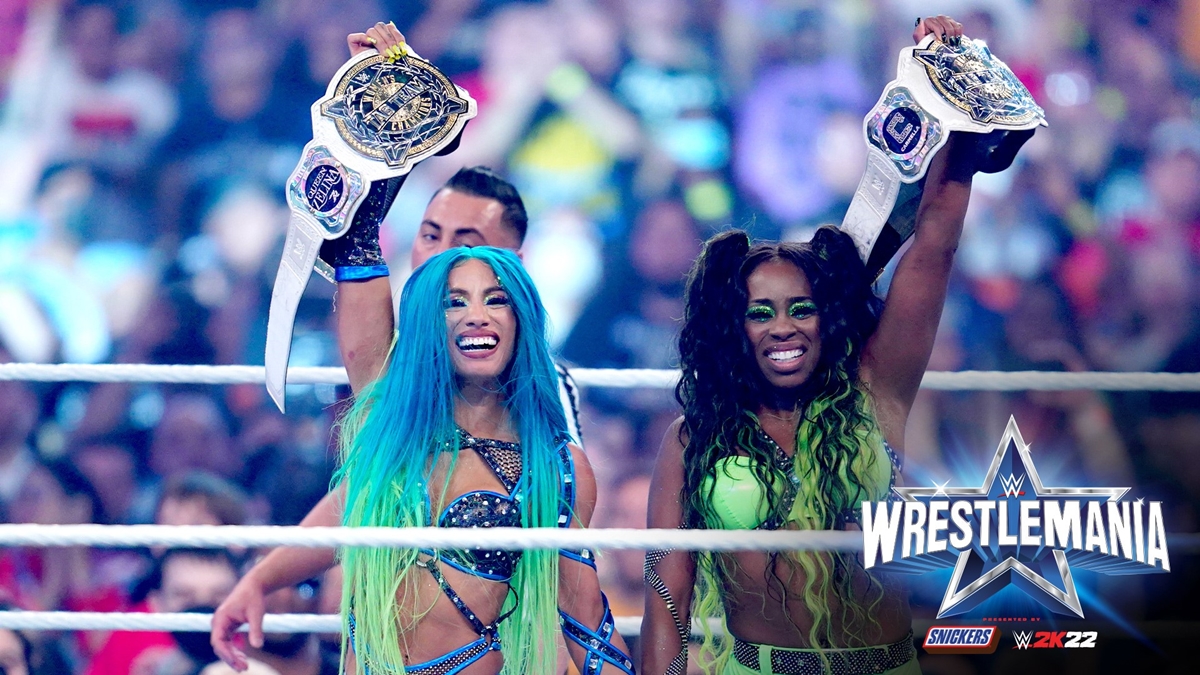The face of a mountain takes on a new meaning when talking about Mount Rushmore.
The blueprint behind Mt. Rushmore’s etchings serve as a framework for debate. The sculptor chose the mountains’ new inhabitants for how they represented birth, growth, development, and preservation. While Mt. Rushmore itself is nothing to be proud of, these qualities serve as a thought-provoking way to start a conversation. When discussing entertainment, sports, writers, sciences, and general history, these qualities can be superimposed into all sorts of narratives.
Yet, choosing the best of anything is problematic. There are so many people in the world, and plenty are extraordinary. When it comes to professional wrestling, especially, there are hundreds of people who lived their lives between those twelve ropes and gave more than they ever received back.
When Trish Stratus, WWE legend, recently released her Mt. Rushmore of women’s wrestling, it sparked this longstanding debate back up. In the face of eternal choices, using the sculptors’ tools can help us begin to chip away at the stone.
Usually when people are asked, “Who’s your pro wrestling Mt. Rushmore?” they inevitably name one man, two men, three men, four. The signifier of “women” has to be stated up front, which is unfortunate yet telling because women wrestlers, just as much as their counterparts, have revolutionized the sport over and over.
Women’s wrestling has been used as sideshow and spectacle by many over the last hundred years. But within an oppressive system, countless women still subverted every expectation, and took charge of their fate.
These four women carved their own silhouette into this mountain. Each of them, additionally, represents something larger than themselves. They helped illustrate a path that many other women could look to as a map.
These are small pieces of their momentous careers that span decades and continents.
Mildred Burke helped modern women’s wrestling define itself and globalize, and twenty years later, Jaguar Yokota advanced the sport beyond Burke’s dreams using her hard-trained and natural talent. A student of Yokota, Aja Kong absorbed her mastery, and flourished within the boundaries set for her, eventually breaking those confines with a stiff spinning back fist. Mercedes Varnado’s childhood was spent being mesmerized by wrestling, and specifically with superstars of the WWF, Eddie Guerrero and Lita. Like Yokota, she took inspiration from luchadors and the women who came before her and created a character out of the heels handbook. She will take care and look after women’s wrestling into the future.
The Birth
“Flesh and Blood”
Mildred Burke
Although there were strongwomen like Minerva, and champion wrestlers like Cora Livingston and Clara Mortenson who predated her, Mildred Burke is known as the mother of lady wrestlers.
As told in the book “Sisterhood of the Squared Circle,” her story began in Kansas, where a young Mildred Bliss worked as a waitress on a Native American reservation at the age of 17. She was a single mother, struggling to support herself and her child. About attending a wrestling match for the first time, Mildred wrote, “Something in my core had been tapped awake…I began fantasizing myself in the ring, applying those grips, holds and throws. A desire and a drive to fill in those fantasies with flesh and blood came surging to life.” She wrote about wrestling with such romance.
Mildred Burke toured Japan in 1954 with her World Women's Wrestling Association.
This directly influenced the formation of promotions that would eventually become All Japan Women's Pro Wrestling in 1968. This promotion in certain ways lead to GAIA, Sendai Girls & Stardom. pic.twitter.com/4y0rEoxVqL
— Catch Wrestling U (@CatchWrestling) March 9, 2022
When she met Billy Wolfe, Mildred became entranced with his stories of the road and she knew she had to be a part of it.
At Billy’s gym down the road from her waitressing job, Mildred donned a black one-piece swimsuit and men’s tennis shoes. Wolfe thought he could get rid of Mildred by putting one of his wrestlers in the ring with her. No such luck, as she swiftly knocked him out. Staring at her standing in the ring, Wolfe must have had dollar signs bulging from his dark-rimmed glasses. In 1934, against her mother’s advice, Mildred took her son and left to travel on the carnival circuit with Wolfe.
At the carnival she continually repeated the same moment she first had in the ring. A man from the audience would challenge her, and she would usually take him out in a matter of minutes, sometimes seconds. When her surname was changed from Bliss to Burke, the fantasy started to materialize.
Wolfe proved to be an abusive monster who beat her, but a line was drawn when he struck and threatened Burke’s son. She told him she would “cut his head off of his body” if he ever did something like that again. His abuse and control over her persisted. Wolfe knew she was the star he could never be, but Burke knew she could not make it in the industry without his connections.
As time went on, the women’s wrestling industry began to expand, giving Mildred more opponents. Burke stated in a 1943 interview that she made upwards of $22,000 in 1943. If true, that equates to almost $385,000 in 2023, making her one of the highest paid athletes in the country.
As the years went on Wolfe continued to edge Burke out of the business they had built together until she pushed all the way out. Once Burke was on her own she helped introduce the newly legalized women’s wrestling to California, toured Mexico, inspiring some of the first luchadoras. She also brought the sport to Japan, inspiring the advent of joshi puroresu. Burke could not have known what would come next. The decades following her visit there would inspire some of the most incredible, impressive, powerful athletes of their generation.
REMEMBER: Ethel Johnson, Babs Wingo, Kathleen Wimbley, & Marva Scott are the original 4 Black women's wrestlers; trained by Mildred Burke.
The 4 were proven draws, including a record 3611 paid in '52 at the Baltimore Coliseum for an all-black women's show.#BlackHistoryMonth pic.twitter.com/9122YZzeab
— SUGE De La Geto (@SugarDunkerton) February 5, 2022
All Japan Women (AJW) soon took over as a powerhouse of women’s wrestling. With Burke’s approval, they adopted her title, the WWWA Championship, into the company in 1968, connecting everyone who holds the championship to the inception of women’s wrestling.
Growth
The Bare Bones
Jaguar Yokota
Jaguar Yokota’s presence in the ring is other-worldly. She almost looks out of place. But it’s not because she does not belong there. On the contrary, her presence is that of a luchador ten years down the line. Her style was unique, shaped by different forces of nature.
Yokota began her training at All Japan Women (AJW) in 1977. She was inspired by the Beauty Pair, a women’s tag team turned pop group sensation, whose idol status proliferated in Japan. Yokota was in the vanguard of a growing industry, and her technical prowess quickly impressed those around her. Only fifteen years old when she started, she was small in stature at only 5’3”.
Women's Pro Wrestling was the biggest thing going in Japan in the 1980s. This is the crowd noise you dream of getting. 🔊🎧
All Japan Women's Pro-Wrestling, 1985 – champion Jaguar Yokota vs challenger Lioness Asuka. #WomensHistoryMonthhttps://t.co/PjgYrwwSXy
— Catch Wrestling U (@CatchWrestling) March 24, 2022
Her dexterity and agility shined through in her speed, a quality she kept throughout her career. Every match of hers is a never-ending loop of holds, reversals, and momentum. The force behind her was multiplied through her masterful use of the ropes and even generated more from how she launched herself, a front facing roundoff using her skull, a move wrestler Natalya Neidhart uses today. Yokota began exhibiting the bare bones of a new style that would sweep the world.
Yokota must have impressed her trainers because she became the inaugural AJW Junior Champion, and AJW Champion straight out of the gate. Championship opportunities continued to barrel towards her when she and Ayumi Hori captured the WWWA tag-team titles. Afterward, she vacated the tag title, promising she would crush the WWWA singles title, the very same Mildred Burke held.
She became the champion, by defeating one-half of her childhood inspirations, Jackie Sato from the Beauty Pair. Yokota’s birth name is Rimi, but during this time in her career, she was knighted as Jaguar, either because of her patented speed, grace, and dexterity, or as an homage to Godzilla’s Jet Jaguar. She held the title for two years until she was defeated by luchadora La Galactica in a hair vs. mask match. She lost her hair and her title that day.
Not only was her physicality jaw-dropping, her acting ability was also masterful. Her in-ring psychology became perfected, every move executed was a domino effect to another. When she was trapped by an opponent she would emote with exaggerated, twisted distortions on her face. Every match was a war, and she fought for every hold she grabbed, demonstrating planned maneuvers, executing them in seconds.
What a roll-up from Jaguar Yokota! #AJW pic.twitter.com/fVPZYFFteX
— SirLARIATO (@SirLARIATO) May 10, 2022
Yokota’s wrestling technique was crafted from her give-and-take relationship with lucha libre. Through watching luchadors and luchadoras who toured Japan, Yokota dissected and manipulated pieces of their style through her joshi-trained eye. From the inspiration she took, she gave some right back. Later, many lucha libre wrestlers would admit to taking from her bag of tricks.
Her finishers included what Triple H would later call the pedigree, but Yokota’s had much more risk and severity. After placing her opponents head between her legs, and hooking their arms in her own, she lifted them straight up, capsized, and brought them down to the mat, their head as their cushion. She also is credited with the creation of the jackhammer, later popularized by Goldberg.
The women Jaguar Yokota ushered in are an important part of her story. After her first retirement in 1986, Yokota began training other mentees and passing on her well-earned wisdom to those who came in behind her. She has trained some of the best wrestlers to grace a ring. Manami Toyota, Aja Kong, Megumi Kudo, Combat Toyoda, Etsuko Mita, Kyoko Inoue, Toshiyo Yamada, Takako Inoue, Bison Kimura, Miori Kamiya, Kaoru Maeda.
In a 2004 interview, Jaguar said she loved to train Megumi Kudo specifically because of her stature, small, like Yokota, and she could teach Kudo all of the moves she loved the most. In the same interview, she said she is happy with the legacy she has left, and when her time in this life comes to end, she will be “Smiling with satisfaction, ringside.”
Development
The Soul
Aja Kong
Erika Shishido’s mother, a Japanese woman, met her father, a Black American military man while he was stationed at Tachikawa Airfield outside of Tokyo. Her mother found herself pregnant soon after their meeting, and when her family found out her baby’s father was Black, they abandoned her and her new family. Erika’s dad, soon after, relinquished his fatherly duties and emigrated back to the United States. It would not be until much later when Erika found out she had two more siblings he had sired.
Read More: How Aja Kong Overcame Racism to Become a Legend
Life as a single mother with a mixed-race daughter proved to be hard for both of them. After entering school, Shishido unfortunately discovered just how cruel children can be when they taunted her because of her mother’s single-parent status and alienated her for being the only mixed-race child at the school. A small respite for Erika, when she was fourteen in 1984, she was apart of the generation of young women who idolized wrestling tag teams like the Beauty Pair, the Crush Gals, and other joshi icons. Women wrestlers were superstars in Japan, with hit singles, television and movie appearances.
At 15 years old, Erika tried out for the AJW class of 1986, and out of the 2,500 who auditioned, she was one of a handful plucked like a daffodil in a field of other flowers. When she got in the ring, her mentors were quick to realize the force she beckoned. She was not built like the other girls in her class, bigger than them, she brought with her a momentum that was something to watch out for.
Erika quickly began sinking herself into the life of a wrestler, and she would labor at the dojo for upwards of fifteen hours a day, where she was put through the ringer with Jaguar Yokota. Not only was there sweat on her brow, she also dove into the ever-important in-ring psychology. After getting her feet wet in AJW, Shishido approached the writers and told them she wanted her character to live in the realm of hero, as she craved the chance to be accoladed.
But the promoters swiftly denied her. They relayed that because of her mixed-race, the only plausible character for her would be one of the villain. They were harkening back to a story that had been told repeatedly in Japanese entertainment. In postwar Japan in the 1950s, wrestler Rikidozan was a hero to Japanese fans in the face of the United States occupation. He ran through foreign competitors, and reinvigorated Japanese audiences with nationwide pride.
AJW promoters told Erika that because she was half Black, she was to be the evil foreigner, whose main job was “crushing” all Japanese competitors. Within this decision, they not only used her Blackness as a weapon, but they amputated her Japanese heritage in one fell swoop. They explained because of Erika’s size there was no way of getting around her heel status. Wrestling has a long history of using plus-size or fat bodies and spinning the yarn of a villain through them.
Erika experienced mounting pressures, and when put between a rock and a bigger rock, she conceded. They dubbed her Aja Kong, after the monster that terrorized the city she grew up in.
After a short amount of time, Aja discovered herself in her heel persona and became a force to be reckoned with. Shortly after her debut, she proved important to the audience, and ended up as a hero of her own creation. She developed her wrestling character so masterfully, and exhibited her talent so effortlessly, that fans fell in love with her.
Other wrestlers even began to look to her as inspiration. “Sisterhood of the Squared Circle” authors claim that when Leon White was working in Japan, he was greatly influenced by many of her moves and finishers to curate his character Big Van Vader.
Aja won the WWWA tag-team titles with several other wrestlers, and began crafting a legacy for herself immediately out of the gate. She was paired with other monster villains like Dump Matsumoto and Bull Nakano, but quickly distinguished herself from the herd.
In 1990, Aja and the aforementioned Bull Nakano met each other in the ring for a legendary bout in a steel cage. After never-ending bumps, stiff shots from pillar to post, and instruments of torture, Nakano revealed a pair of scissors in her hands. She thrusted them into the arms of Aja, tearing open her skin, resulting in a bloody trail. But, Aja, the soul of this bout, continues on, and even when she is met with defeat, everyone in the stadium knew the brutality she was capable of.
Bull Nakano hits Aja Kong with a Leg Drop from the TOP of the CAGE – AJW (11.14.1990) pic.twitter.com/uJRx8l5HO6
— Dark Puroresu Flowsion (@PuroresuFlow) February 7, 2023
Only two years later, Aja bested Nakano gripping her fingers around the WWWA Singles Championship. She became the first Black woman to grasp the title since Sandy Parker had done so in 1973 almost twenty years earlier.
After getting an opportunity in the WWF in 1995, Aja put on some incredible matches at Survivor Series and on two episodes of Raw. When Alundra Blayze took her title to WCW, Aja lost her chance to capture the championship and went back to Japan.
Her return saw the beginning of a partnership with the legendary Kia Stevens, who was known as Awesome Kong.
In the late 90s, Aja started the wrestling company ARSION alongside Rossy Ogawa, but she subsequently removed herself from the company, even suing its president, who would go on to create Stardom.
Aja Kong, today, is a superstar in Japan, and guest stars on various TV programs. Her fame echoes outwards though, and she is a legend of the wrestling worldwide. She made a guest appearance in All Elite Wrestling (AEW), coming face to face with her longtime compatriot, Awesome Kong. Time has not affected her brutality. As of March of 2023, Aja was in a hard-hitting bout with Masha Slamovich at Prestige Wrestling.
“God made the Devil just for fun, When he wanted the real thing, He made Aja Kong!” go the lyrics of her walkout music. Aja might be stronger, fiercer, and scarier than the Devil in a ring, but the truth is that she brings much, much more to professional wrestling than just villainy. Her story, blood, and heart are all pierced through the canvas for the audience to see, and what is left is a beautiful painting unveiling her soul.
Preservation
The Heart
Mercedes Monè
Mercedes Varnado has a romantic way of speaking about wrestling, she waxes poetically on the ways she loves it, how she craves it when they are apart, and how its spirit remains stuck in her heart no matter what she does.
While growing up Mercedes was obsessed with wrestling, with a certain predilection towards Eddie Guerrero, Rey Mysterio, and Lita. Repeatedly, she has reported how she knew her destiny was to be a wrestler since she was ten years old. When she is in the ring, audiences feel how her fandom, skill, and soul meet one another in a frenzy under the lights.
Mercedes decided it was time to start her wrestling journey at sixteen, and living in Boston at the time, began training at Chaotic Wrestling School outside of the city. After catching the eyes of her trainers, they gave her a three-month scholarship to get started. That three-month grant would end up blossoming into a career of thirteen years and counting.
Mercedes was a hardcore fan of wrestling, and devoured joshi puroresu matches from AJW, featuring wrestlers like Manami Toyota, Jaguar Yokota, and Aja Kong. At the beginning of her wrestling journey, she hoped to follow in many of those women’s steps and wrestle in Japan or Mexico, but the United States had other plans for her.
In summer of 2012, WWE held a tryout for new talent, and Mercedes left Boston for Florida. In the book “Encyclopedia of Women’s Wrestling” author LaToya Ferguson discusses how Mercedes reported she almost did not get signed at all in the company. Apparently, the executives did not think she had the “Diva look,” but William Regal thought differently. He pressed them to give her a chance and bring her on.
She debuted in WWE’s training division in late 2012, and although she started her career as a heroic, smiley face, it did not take long for her to follow in the footsteps of her favorite wrestler Eddie Guerrero’s lie, steal, cheat. The character of Sasha Banks began to take form as she took inspiration from her cousin Snoop Dogg, WWE Hall of Famer and world-famous celebrity. This step helped her chip away at the vast options, and Mercedes began to sculpt herself into “the boss.”
With rings of dollar signs sparkling her on fingers, sunglasses, and glitter, Sasha Banks continued to grow.
As Sasha Banks, Mercedes conquered the women’s wrestling division at NXT, where she put on legendary matches with three other women who would come to shift women’s wrestling as we knew it. At NXT: Takeover 2015, Mercedes swiped Charlotte Flair’s title in a fatal four-way match between the two and Becky Lynch and Bayley. This quad of women would become known as the Four Horsewomen, their namesake a call-back to Attitude Era wrestling days of yore, and of course, the four plagues ushering in the apocalypse. Although these women would go on to herald something even more remarkable.
It was summer of 2015 when Mercedes graduated to WWE’s main roster, debuting at Monday Night Raw, although she remained the NXT Women’s Champion.
The same year, she and Bayley headlined another NXT pay-per-view with a 30-minute iron man match that is still referred to as one of the best matches in WWE history. Mercedes and Bayley would go on to build a relationship that still holds on to the present day. Throughout the next seven years, Mercedes and her peers put on showstopper after showstopper.
For the last decade or so, women wrestlers in the WWE were known as Divas, while the men were dubbed Superstars. The work that women like Chyna, Ivory, Jacqueline, Victoria, Trish Stratus, Mickie James, Lita and even more had put in, slowly chipped away at the mountain. The women’s division of Mercedes’ era was pushed even further by so many people like Nikki and Brie Garcia, Trinity Fatu, Tamina Snuka, Alicia Fox, Saraya Knight and more. In 2016, the moniker of Diva was finally, like their women’s storylines for so long, stripped.
Over the next six years, Mercedes became a seven-time champion in the Raw, Smackdown, NXT and tag-team divisions. One of her countless highlights, in 2021, was when she and Bianca Belair became the first two Black women to headline Wrestlemania. As the match began, the two allowed themselves to break character, and gift the other a teary-eyed recognition, before making history. Thinking of the match they put on still sends shivers down fans’ spines.
After losing her title to Belair, Mercedes’ journey continued into the women’s tag-team division where she and Bayley had dominated. Now she and Naomi (Trinity Fatu) were the next to claim the titles. They were an exciting change for fans, but their run proved to be short. Naomi and Mercedes walked out of a meeting with WWE’s creative team, packed up their championship belts, and left the arena they were to perform in that night. After having creative disputes with WWE writers and Vince McMahon in the past, Mercedes had taken hiatuses from the company before, but this time was different.
Both women were released of their WWE contracts. Details have not been confirmed by either parties beyond the stated creative differences.
After mourning the loss of a company she had spent over a decade with, Mercedes promptly began expanding outwards and reached towards another dream of hers since she started wrestling.
In January of this year, she debuted at New Japan Pro Wrestling (NJPW) as Mercedes Monè. She immediately challenged KAIRI, an ex-WWE wrestler herself, for her IWGP Championship belt. At their most recent pay-per-view Mercedes claimed the title as her own, and is now the second-ever champion.
While at her premiere match, Mercedes took time from celebrating her new start to honor another person. Mercedes paid homage to the outfit that wrestler Hana Kimura wore in the ring. An impressive in-ring presence, and popular wrestler at Stardom, Kimura took her life in 2020. Monè showed appreciation in the way a wrestler can, and while doing so she reveals to fans her heart.
Mercedes Monè ring gear is in tribute to
Hana Kimura gearBattle In The Valley pic.twitter.com/MkGg4RG1uu
— GETCHO! 🇺🇸🇵🇭🇹🇭🇲🇽🇧🇷 (@GetChoPodcast) February 19, 2023
Discussing a career that is still growing is difficult. Her legacy looms larger with every move she makes, and with her expansion into the independent wrestling scene, movies, and television, we will all be talking about Mercedes and therefore women’s wrestling for years to come.
Conclusion
There are too many wrestlers to sculpt into this mountain of celebration, and each deserves a beautiful rendering of their image. Throughout this explanation, the people carved in this mountain represent 100 other wrestlers, people, moments, histories, and legacies.
The subjects of the debate will be changed, altered, and shifted simply because it is never-ending. All good things live and breathe, and wrestling is no different. It does not exist in stagnation, it is ever-evolving.
So, tell me, who’s your Mt. Rushmore?
Some other honorable mentions: Chyna, Chigusa Nagayo, Manami Toyota, Awesome Kong, Mae Young, Bull Nakano, Ethel Johnson, Natalya Neidhart, Jacqueline, Luna Vachon, Akira Hokuto, Candace LaRae, Lita, Bianca Belair, Mayu Iwatani, Athena, Bayley, Asuka, Trinity Fatu, Marva Scott, Alundra Blayze, Io Shirai, Beth Phoenix, Irma Gonzalez and so, so many more.






